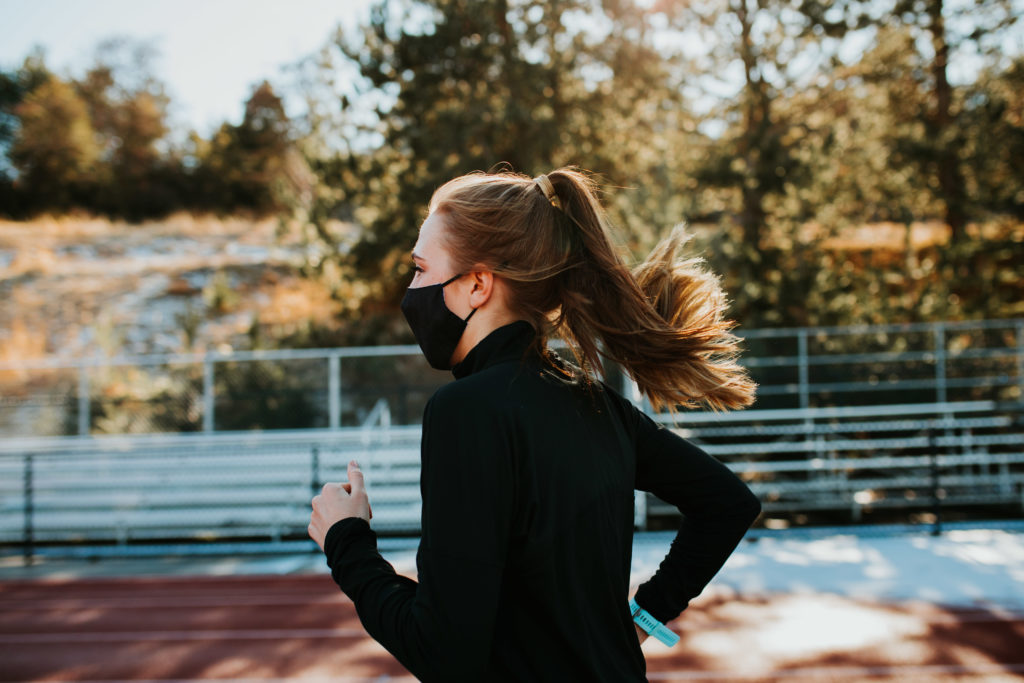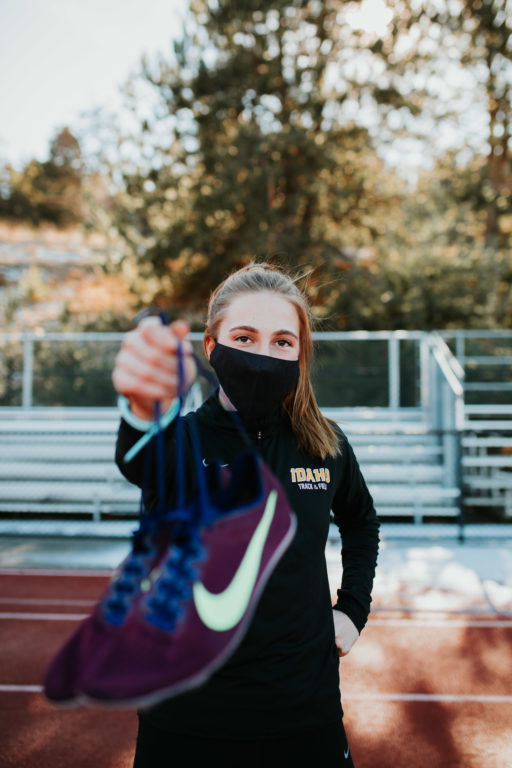Erica Pecha sits on a bench as her nimble fingers tie the dark blue laces of her worn down running shoes. She stands up and adjusts her ponytail, her eyes scanning the track in front of her. As she runs, the swish of her ponytail is highlighted by the golden glow of sunlight. Her deep purple shoes pound against the red track. She lets her mind go, focusing on the white lines of the track. Her breathing gets harder and her legs push her forward, the white outline of the Kibbie Dome disappears in the background as she powers on.
Pecha, a cross country and distance runner, is one of many women in the athletics department at the University of Idaho. As an athlete in 2021, Pecha has opportunities previous women never got to see, but it doesn’t come without its challenges. Female athletes today still face outside perspectives and stigma formed by gender bias.
| Photos by Nataly Davies
THE PAST
UI President C. Scott Green stands in front of a podium, a university backdrop behind him. He unfolds the paper on which he’s written his speech, and pulls his rectangular glasses out of his pocket to rest them on his face.
Green looks down, reading the speech as reporters watch silently. In the introductory press conference he describes the hunt for a new athletic director and announces the first female to hold the position in university history, Terry Gawlik.
Because of her career as a collegiate female athlete and sports administrator, Gawlik understands the challenges women experience within athletics. Gawlik held many positions within collegiate athletics over the span of her 25-year career, which started after her own time as a college athlete.
Gawlik said she has seen many changes in athletics over that time, including a shift to make athletics an equal space for both men and women. Previously, female athletes were offered very limited opportunities. Even within the sports they were allowed to play, they were not allowed to play in the same ways men did.
“Long ago, even before I started playing, the mantra was ‘well, women shouldn’t run that much because you might damage your bodies and you can’t have kids’,” Gawlik said. “Even before I played, there was rules that you can only dribble twice or once, so we really weren’t supposed to be doing these kinds of things.”
A big component of change over the pastseveral years has been Title IX, a federal law focused on equal education rights based on sex. Title IX was passed in 1972, several years before Gawlik started her career, however for many years the law was not applied to athletics.
Gawlik said she refers to Title IX as two different areas. The first area focused on sexual assault and sexual harassment in higher education, the second focused on providing equal opportunities based on sex.
“A lot of people think Title IX is just about sexual assault and sexual harassment, but it’s also monitoring all the areas of equity,” Gawlik said. “Whether it be the way we travel. What kind of meals we get, what kind of equipment, and I’m happy to say that in our department that is a
high priority.”
Because of Title IX, women are given more athletic opportunities on a collegiate level. Title IX ensures women in athletics have equal access to scholarships, equipment and other needs for athletes and their teams.
“What I really appreciate is the opportunity for anybody to play sports,” Gawlik said. “I think sports is leadership building, team building. There’s nothing like the locker room culture … you support each other and challenge each other and call each other out. So to me, being a part of athletics really develops people.”
THE PRESENT
While opportunities for women have opened up in huge ways, many women still struggle with outside perspectives on how they should and shouldn’t act. Donnée Janzen, a setter for the UI volleyball team, began playing sports as a child but often found stigma attached to her passion.
“There definitely was a lot of pushback,” Janzen said. “I think some people were very uncomfortable with it, and I think a lot of males were very intimidated by the fact that I’m tall, I’m loud, I’m strong, I’m independent.”
Janzen prefers to disprove the stigma surrounding women in sports by showing them what she can do. She said she likes to use her athletic talent to show just how strong and capable women can be.

However, other female athletes are not always given the same attention and focus as male athletes. Gina Marxen, a guard on the women’s basketball team at UI, said women’s sports do not have as large of a fan base as the men’s teams.
“I see on social media different acknowledgment of males in sports getting
these big praises and something happens on the women’s side I don’t see as much of an acknowledgment of that, even though they’re just as important and just as impressive.” Marxen said.
Despite women working extremely hard at their sport, others don’t always value their hard work. Kaysie Bruce, a midfielder for the UI soccer team, said people tend to think femininity and hard work in athletics are mutually exclusive.
“There’s definitely a hard balance between a jock and just being a female athlete who wants to wear makeup and look pretty,” Bruce said. “We always want to show everyone our best but sports can sometimes really draw out insecurities, so trying to stay on top of those things I think
is hard.”
Finding the balance between femininity and strength can be difficult for athletes. Bruce said that the struggle to find balance between the two spans into larger issues such as physical health and body image.
| Courtsey Vandal Athletics
“I think one of the main struggles that I have seen playing college athletics for the last three and a half years has been more focused on body image,” Bruce said. “It’s always a comparison game.”
While building muscle helps athletes in their sport, because of public perception of ideal body types for women, many don’t feel comfortable with the way their bodies look. Pecha said that in the case of track athletes, some women believe slimmer bodies will help them run faster.
“I know a lot of runners who fell into that stigma and tried to lose a bunch of weight or get super fit and did it the unhealthy way,” Pecha said. “It’s just not sustainable.”
Despite stigma and the constant comparison, Bruce and Pecha advocate for how important it is to love your body the way it is. Each athlete is unique, and the body they have built for their sport is important.
“(Your body) allows you to play the sport you’re playing,” Bruce said. “It’s given us so many opportunities, so we shouldn’t not love our body because it’s the main reason we’re here … body image is definitely, I think, one of the harder things for female athletes to go through. But I think we help each other in the fact that you know we’re all in the same boat.”
THE FUTURE
When Gawlik was young she played half-court basketball, her Chuck Taylors squeaking against the gym floor as she ran. She never imagined she would be an athletic director, and she never could have anticipated the changes that were in store for future generations of female athletes.
“Women can compete at such a high level, just like men,” Pecha said. “Seeing women breaking records and running just as fast as men … it’s really cool, and it’s empowering to see that women can be strong and athletic too.”
As more women’s sports are being covered both on television and in print media, young girls can watch as national teams such as the US women’s soccer team win gold medals in the Olympics and players like Serena Williams, Lindsay Whalen and Emma Coburn show others just how talented female athletes can be. The collegiate athletes believe it is also their responsibility as women in sports to be role models for young girls who are interested in athletics.
“Being a female athlete comes with empowering and inspiring younger female athletes,” Marxen said. “In the past, women haven’t had the opportunities to play the sports that we do now and I think that just goes
to show the progress that we’ve made and how working hard can lead to achieving your goals. I think it shows how much change we’ve been able to make.”
Janzen volunteers as a coach to younger girls in her time off the court, and believes it’s her job to use her talent to give back
to her community.

“I love being able to bring up the younger generations,” Janzen said. “I’ve been in the sport for quite a long time, and I’ve learned some tricks of the trade along the way. I love being able to share that with younger girls, and I’ve coached girls anywhere from ages six to 16.”
The future is extremely uncertain, nobody knows what’s in store for the next generation. However, Janzen believes one of the most important steps that needs to be taken is addressing the stigma around women in sports.
“I think the more we can de-stigmatize this idea of women in sports and women being strong and powerful and having a voice, the better it’s going to be not only for us, but also future generations,” Janzen said.
Janzen watches as the young girl she’s been coaching sets up for the shot, her knees apart and her feet slightly bent. On the court, the girl watches as the ball crosses the net, her arms come together and she lunges forward. The ball meets her wrist and she bumps it over the net.






